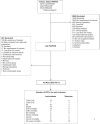Selenium, antioxidants, cardiovascular disease, and all-cause mortality: a systematic review and meta-analysis of randomized controlled trials
- PMID: 33053149
- PMCID: PMC7727482
- DOI: 10.1093/ajcn/nqaa245
Selenium, antioxidants, cardiovascular disease, and all-cause mortality: a systematic review and meta-analysis of randomized controlled trials
Abstract
Background: Antioxidants have been promoted for cardiovascular disease (CVD) risk reduction and for the prevention of cancer. Our preliminary analysis suggested that only when selenium was present were antioxidant mixtures associated with reduced all-cause mortality.
Objective: We conducted a systematic review and meta-analysis of randomized controlled trials (RCTs) to determine the effect of selenium supplementation alone and of antioxidant mixtures with or without selenium on the risk of CVD, cancer, and mortality.
Methods: We identified studies using the Cochrane Library, Medline, and Embase for potential CVD outcomes, cancer, and all-cause mortality following selenium supplementation alone or after antioxidant supplement mixtures with and without selenium up to June 5, 2020. RCTs of ≥24 wk were included and data were analyzed using random-effects models and classified by the Grading of Recommendations, Assessment, Development, and Evaluation approach.
Results: The meta-analysis identified 9423 studies, of which 43 were used in the final analysis. Overall, no association of selenium alone or antioxidants was seen with CVD and all-cause mortality. However, a decreased risk with antioxidant mixtures was seen for CVD mortality when selenium was part of the mix (RR: 0.77; 95% CI: 0.62, 0.97; P = 0.02), with no association when selenium was absent. Similarly, when selenium was part of the antioxidant mixture, a decreased risk was seen for all-cause mortality (RR: 0.90; 95% CI: 0.82, 0.98; P = 0.02) as opposed to an increased risk when selenium was absent (RR: 1.09; 95% CI: 1.04, 1.13; P = 0.0002).
Conclusion: The addition of selenium should be considered for supplements containing antioxidant mixtures if they are to be associated with CVD and all-cause mortality risk reduction. This trial was registered at https://www.crd.york.ac.uk/PROSPERO/ as CRD42019138268.
Keywords: all-cause mortality; antioxidants; cardiovascular disease; meta-analysis; selenium; supplements.
© The Author(s) 2020. Published by Oxford University Press on behalf of the American Society for Nutrition.
Figures





References
-
- Moyer VA. Vitamin, mineral, and multivitamin supplements for the primary prevention of cardiovascular disease and cancer: U.S. Preventive Services Task Force recommendation statement. Ann Intern Med. 2014;160(8):558–64. - PubMed
-
- Gahche J, Bailey R, Burt V, Hughes J, Yetley E, Dwyer J, Picciano MF, McDowell M, Sempos C. Dietary supplement use among U.S. adults has increased since NHANES III (1988–1994). NCHS Data Brief. 2011;(61):1–8. - PubMed
-
- Finkel T, Holbrook NJ, Oxidants, oxidative stress and the biology of ageing. Nature. 2000;408(6809):239–47. - PubMed
-
- Steinberg D. Antioxidant vitamins and coronary heart disease. N Engl J Med. 1993;328(20):1487–9. - PubMed
-
- Kushi LH, Folsom AR, Prineas RJ, Mink PJ, Wu Y, Bostick RM. Dietary antioxidant vitamins and death from coronary heart disease in postmenopausal women. N Engl J Med. 1996;334(18):1156–62. - PubMed
Publication types
MeSH terms
Substances
LinkOut - more resources
Full Text Sources
Medical

